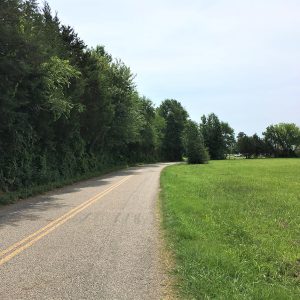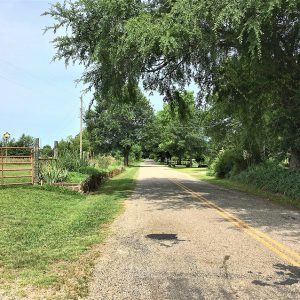calsfoundation@cals.org
Anderson (Scott County)
Located between Highway 80 and Highway 71 along Sweet Gum Lane, Anderson is an unincorporated community in central Scott County one mile northwest of Waldron (Scott County). The agricultural industry was vital to area settlers and later residents.
The area’s first inhabitants included natives from the Archaic, Woodland, and Mississippian periods. Archaeological discoveries suggest that natives of the Caddo Nation made their homes along the Poteau River and other prominent waterways in the area. Thousands of archaeological sites can be found along the Fourche La Fave River and Poteau River valleys nearby.
Throughout the late seventeenth and early eighteenth centuries, French hunters and tradesmen traveled west from Arkansas Post along the Arkansas River. From there, they began traversing smaller tributaries such as the Fourche La Fave and Poteau rivers. It is likely that they traveled through the area where Anderson is now located.
The people of the Choctaw Nation were present for a time in various areas of Scott County from 1820 to 1830. In Waldron, 2nd Street was once known as Choctaw Road.
Early white settlers began arriving in the area near Anderson in the late 1820s and early 1830s. Most families participated in a wide variety of agricultural practices. It is unclear as to when the community of Anderson was officially established; however, it is likely that the community was named after the Anderson family who came to Scott County from Dade County, Georgia, in the 1880s. The family lived near the present location of Anderson, about two miles west of Waldron. Theodore and Sephronia Anderson came to Scott County with their children: William, Joseph, Mary, James, and Benjamin. Theodore died in 1887 shortly after arriving in Scott County, while Sephronia died in 1897. They are both buried in Sehorn Cemetery near the community of Winfield west of Waldron. Joseph F. Anderson was known for the prize-winning Plymouth Rock chickens that he bred. Joseph died in 1946 and is buried at Duncan Cemetery in Waldron. Mary Anderson stayed in Scott County and married George M. Smith; she died in 1942. James Nathan Anderson moved to Del Rio, Texas, where he died from consumption (tuberculosis) in 1909; he is buried in Del Rio. Benjamin Anderson reportedly married three times throughout his life. He died in 1928 from heart disease in Heavener, Oklahoma. There is little information about the oldest brother William F. Anderson.
In 1901, the Arkansas Western Railroad, a subsidiary of the Kansas City Southern, built a 31.7-mile line east from Heavener to Waldron in order to service the timber industry. Anderson was the last community located along the route before the tracks reached Waldron.
Because it is located less than a quarter of a mile from Waldron’s city limits, Anderson is close to becoming absorbed due to expansion and sprawl, although it maintains a few business and churches. Anderson is served by Waldron’s school district. The agricultural industry is still present in Anderson, although it has become less prominent over the years. Cattle and chicken farms make up the majority of agriculture in the area.
For additional information:
Cate, Michael. History of Scott County, Arkansas. Dallas, TX: Curtis Media Corporation, 1991.
Echoes: The Scott County Historical and Genealogical Society Quarterly. Waldron, AR: Scott County Historical and Genealogical Society (1986–).
Goodner, Charles. Scott County in Retrospect. Mansfield, AR: Frank Boyd, 1976.
Goodner, Norman. A History of Scott County, Arkansas. Siloam Springs, AR: Bar D Press, 1941.
McCutcheon, Henry Grady. History of Scott County, Arkansas. Little Rock: H. G. Pugh and Company, 1922.
Ty Richardson
Richardson Preservation Consulting
 Agricultural Land
Agricultural Land  Anderson View, East
Anderson View, East  Anderson View, West
Anderson View, West  Scott County Map
Scott County Map 




Comments
No comments on this entry yet.